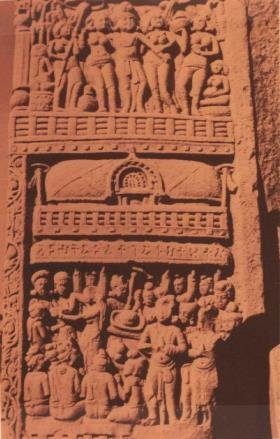Matangalila and Hastyayurveda (study)
by Chandrima Das | 2021 | 98,676 words
This page relates ‘Ivory and Trade’ of the study on the Matangalina and Hastyayurveda in the light of available epigraphic data on elephants in ancient India. Both the Matanga-Lila (by Nilakantha) and and the Hasti-Ayurveda (by Palakapya) represent technical Sanskrit works deal with the treatment of elephants. This thesis deals with their natural abode, capturing techniques, myths and metaphors, and other text related to elephants reflected from a historical and chronological cultural framework.
Ivory and Trade
Elephants formed a major commodity of trade and there are several inscriptions which bear testimony to such dealings in elephants. Besides this ivory was also a major product. A Prakrit inscription records that carving (rupakaṃma) was done by the Vedisaka workers in ivory (daṃtakāras of Vediśā)[1]. It indicates towards the presence of a guild of the ivory carvers from Vidiśā. Epigraphs also refer to the ivory carvers, their guilds, donation of ivory tax to donees and the royal monopoly on ivory.

[7. Vidisa ivory carvers' panel at Sanchi.]
The Sonpur plates of Kumāra Someśvaradeva states that the donees of this charter, were given all sorts of liberalities including the freedom of enjoying the tusks of elephants, which were the monopoly of the king in the ancient times[2]. In the context of procuring of tusks or ivories there is a text which supplies significant information. Kalpanāratnam[3] a text on this subject composed by the Gaṅga king Śivamāra who ruled some parts of Karnataka in the 8th and 9th centuries CE, sheds new light on the preservation of elephants and their ivory. The word “Kalpanā” means here the art of cutting the tusks of elephants so that the ivory could be used for making useful and beautiful articles, without harming the pachyderms. In the light of this, it was necessary to know the proper time to cut the tusks of elephants and also the proper method of preserving the ivory. By studying this text, we know the various genres of elephants, their nature, behavior and also the proper method of preserving ivory.
In ancient times elephants were used for army and for transportation of heavy goods. Indian elephants are famous for their fighting ability; so it is quite natural selling of elephants was most common and profitable and that it was one of most eminent part of royal treasury through taxation on it. We have discussed the trade in elephants and ivory in detail in chapter 5.
Footnotes and references:
[1]:
[3]:
H.V.Nagaraja Rao. ed.& tr. Śrī Śivamārabhūpāla Praṇītam Kalpanāratnam, Bangalore: Poornaprajna Samsodhana Mandiram, 2009.
